
Coober Pedy is a town in northern South Australia, 846 km (526 mi) north of Adelaide on the Stuart Highway. The town is sometimes referred to as the "opal capital of the world" because of the quantity of precious opals that are mined there. A blower truck is raised above the town sign, representing the importance of opal mining to the town's history. Coober Pedy is also renowned for its below-ground dwellings, called "dugouts", which are built in this fashion due to the scorching daytime heat.

William Creek, in the Outback region of the Australian state of South Australia, is an isolated township with a population of fewer than 20. It is located about half-way along the Oodnadatta Track, 210 km (130 mi) north-west of Marree and 166 km (103 mi) east of Coober Pedy.
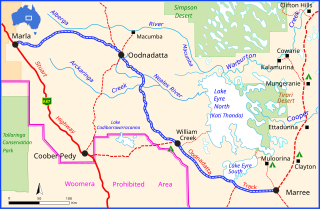
The Oodnadatta Track is an unsealed 614 km (382 mi) outback road in the Australian state of South Australia, connecting Marla in the north-west via Oodnadatta to Marree in the south-east. Along the way, the track passes the settlements of Oodnadatta and William Creek, the southern lake of the Kati Thanda-Lake Eyre National Park, and mound springs known as Freeling Springs, Strangways Springs, and The Bubbler and Blanche Cup.
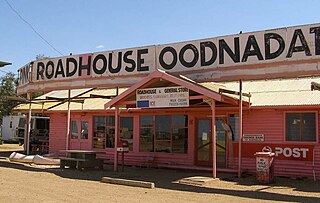
Oodnadatta is a small, remote outback town and locality in the Australian state of South Australia, located 1043 kilometres north-north-west of the state capital of Adelaide by road or 873 km (542 mi) direct, at an altitude of 112 metres. The unsealed Oodnadatta Track, an outback road popular with tourists, runs through the town.

Anna Creek Station is the world's largest working cattle station. It is located in the Australian state of South Australia.

Dalhousie Springs, also known as Witjira-Dalhousie Springs, is a group of over 60 natural artesian springs located in Witjira National Park on the western fringe of the Simpson Desert, 180 kilometres northeast of Oodnadatta in northern South Australia. They are about 250 kilometres (160 mi) southeast of Alice Springs.
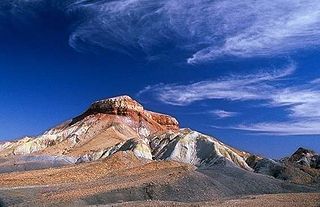
The Painted Desert is in the Far North of South Australia. It is 120 kilometres (75 mi) north-east of Coober Pedy, in the Arckaringa Station pastoral lease, not far from the homestead. It is notable for its distinctive mesas, mountains, and geological formations. Not far from here on the way to Oodnadatta, there are large areas of ground covered with mica. The entire region is desolate and made up of soft, fragile rock.
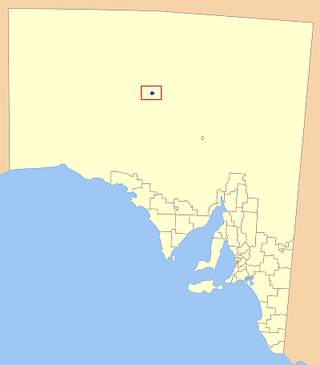
The District Council of Coober Pedy is a local government area located around the opal mining town of the same name in Outback South Australia. The district's economy is based on the large opal deposits found beneath it, which have made it a major mining centre and also a popular tourist destination.
The Kanku-Breakaways Conservation Park, formerly known as The Breakaways Reserve or simply The Breakaways, is a protected area in northern South Australia, just off the Stuart Highway 33 km (21 mi) north of Coober Pedy.

Tamarix aphylla is the largest known species of Tamarix, with heights up to 18 metres (59 ft). The species has a variety of common names, including Athel tamarisk, Athel tree, and Athel pine. It is an evergreen tree, native across North, East, and Central Africa, through the Middle East, and into parts of Western and Southern Asia.
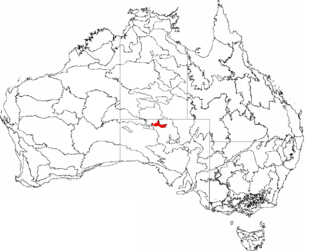
The Pedirka Desert is a small Australian desert, about 100 kilometres (62 mi) north-west of Oodnadatta and 250 kilometres (160 mi) north-east of Coober Pedy in South Australia. Mount Dare and Witjira National Park are just to the north.

Arabana or Arabuna is an Australian Aboriginal language of the Pama–Nyungan family, spoken by the Wongkanguru and Arabana people.
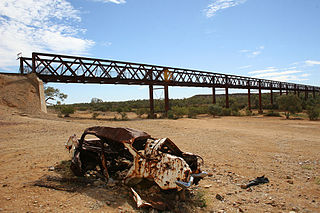
The Algebuckina Bridge is a Victorian era railway bridge in the Australian state of South Australia located about 55 kilometres (34 mi) south-east of the town of Oodnadatta in the locality of Allandale Station on the route of the now-closed Central Australia Railway. It opened in January 1892. It was the longest bridge in South Australia until construction of the Seaford suburban rail line across the Onkaparinga River south of Adelaide in 2014.

Arckaringa Station is a pastoral lease in the Australian state of South Australia which that once operated as a sheep station but now operates as a cattle station.

Stuarts Creek is a remote locality in the Australian state of South Australia in the states's Far North region. The name and boundaries were formalised on 26 April 2013, named after Stuart Creek Station, in respect of the long established local name.
Mount Willoughby is a locality in the Australian state of South Australia located about 837 kilometres north-west of the capital city of Adelaide and about 84 kilometres north-west of the town of Coober Pedy.
Oodnadatta is a town and locality in South Australia.
Allandale Station is a locality in the Australian state of South Australia located about 848 kilometres (527 mi) north of the state capital of Adelaide and about 20 kilometres (12 mi) south-east of the town of Oodnadatta.
Manguri Siding is located in the Adelaide–Darwin rail corridor at the locality of Mount Clarence Station, about 42 kilometres (26 mi) west of the opal mining town of Coober Pedy.
Mount Clarence Station is a locality in the Australian state of South Australia located about 771 kilometres (479 mi) north-west of the state capital of Adelaide and about 37 kilometres (23 mi) west of the town of Coober Pedy.


















